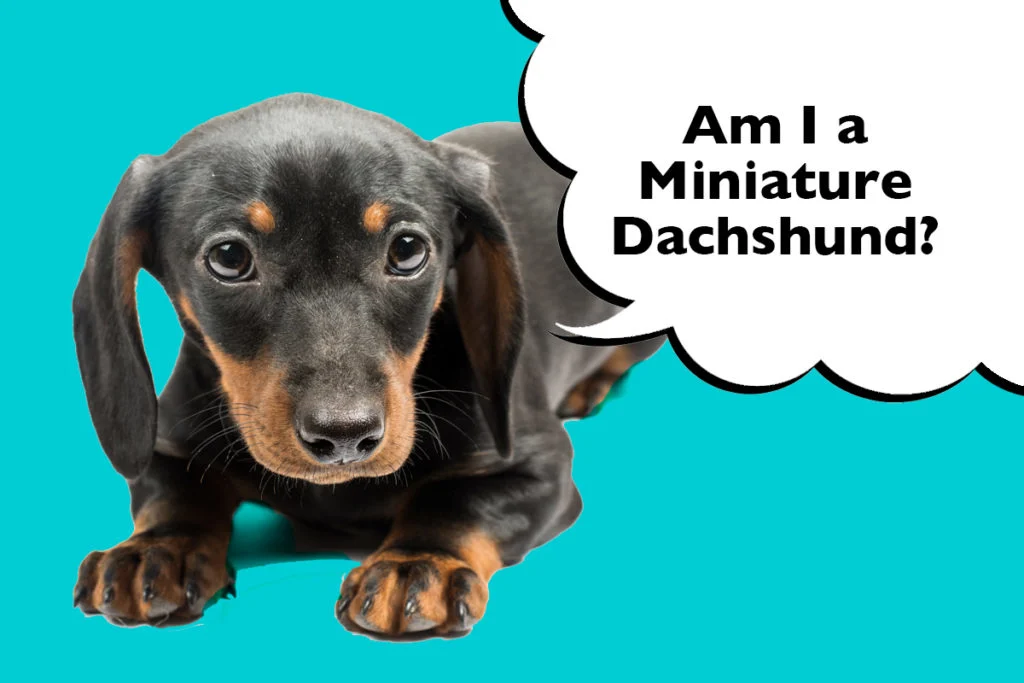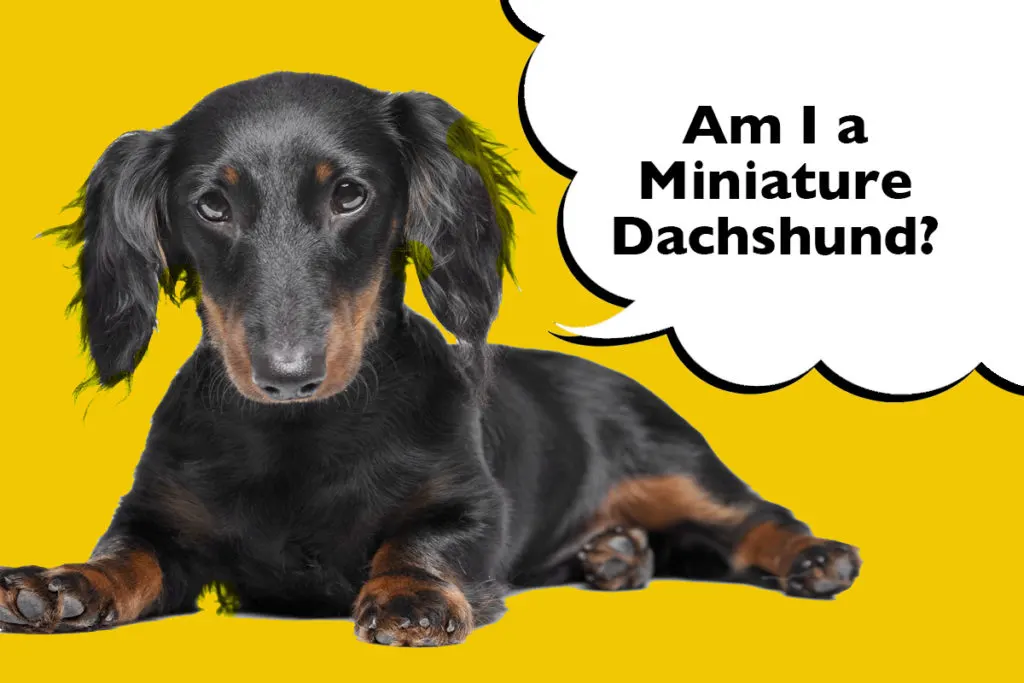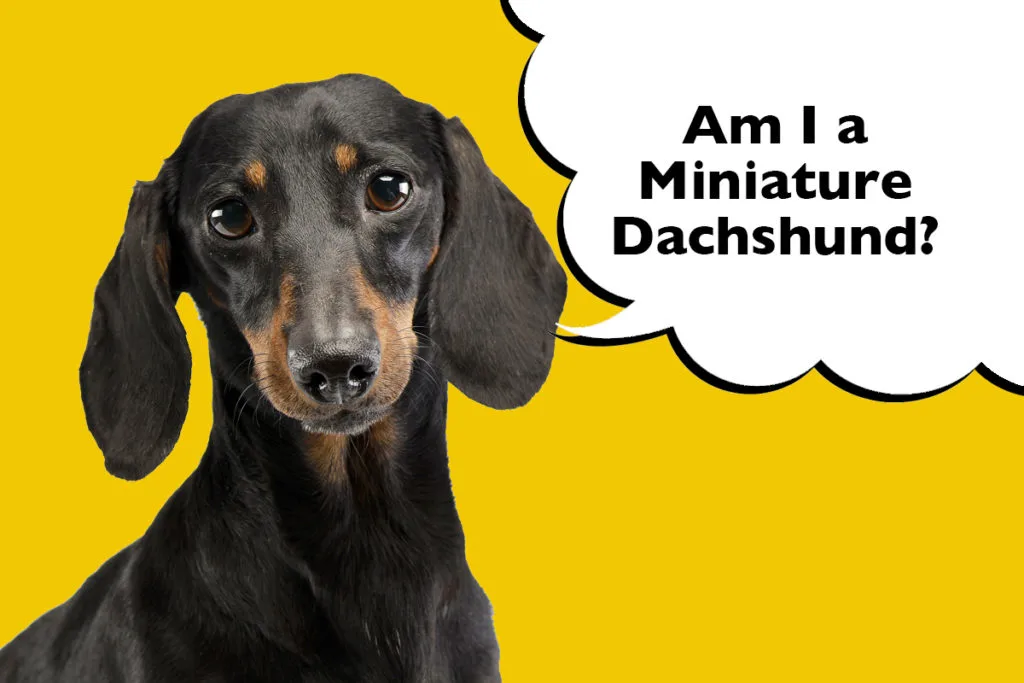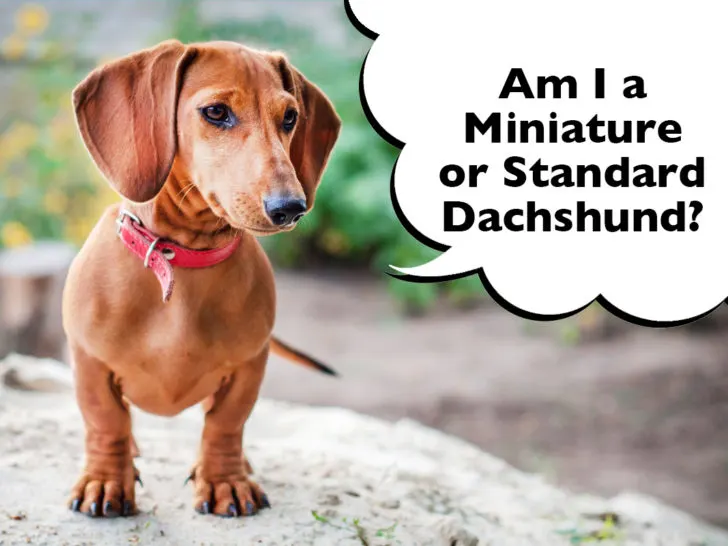Are you wondering whether your Dachshund is Miniature or Standard size? Is your puppy growing more than you thought? Or maybe you want to find out which size of Dachshund may be right for you? Here’s everything you need to know about Miniature and Standard Dachshunds.
Is My Dachshund Miniature Or Standard Size? If your fully grown Dachshund weighs less than 11 pounds, they are a Miniature. However, some Miniature Dachshunds can grow much bigger than the breed standard sizes, and still be classed as Miniature. If both parents are ‘Miniatures’, then the puppy will also be a ‘Miniature’, regardless of size.
Read on to find out more about the personality differences between Miniature and Standard Dachshunds, and the lifespan, health and training needs of the breeds.
Never use the advice in this article as a substitute for professional veterinary advice or treatment. I am NOT a Vet, qualified dog trainer or dog behaviourist. This article is based on research, personal opinion and experience of owning dogs over the last 12+ years.
What Are The Differences Between Miniature And Standard Dachshunds?
The physical differences between Miniature And Standard Dachshunds are:
Standard Dachshund
- Height: 20 to 22 cm
- Weight: Between 16 and 32 pounds
- Originally bred to hunt prey like badgers
Miniature Dachshund
- Height: 13 to 18 cm
- Weight: Up to 11 pounds
- Originally bred to hunt smaller prey like rabbits
As you can see, the main difference between Miniature and Standard Dachshunds is their size.
Miniature Dachshunds are generally much smaller than Standard Dachshunds at around 13 to 18 cm or 5 to 6 inches to the top of their shoulder blades (or ‘withers’ as they are known).
Whereas Standard Dachshunds are bigger at 20 to 22 cm or 8 to 9 inches to the top of their shoulder blades.
However, as mentioned before, many Miniature Dachshunds can grow much bigger than the breed standard measurements listed above.
And, if both parents are down as “Miniatures” on the official paperwork from the dog breeder, then the puppy will still be a “Miniature”, regardless of the size they grow to.
If you’ve rescued your Dachshund or don’t have any paperwork, then the best way to tell whether they are Miniature or Standard is to simply measure them with a ruler or tape measure. Do this once they reach full size at about 12 months old.
This isn’t an exact science if you don’t know their lineage or have any information about their parents or background, but it’s the best method you’ve got!
You can weigh your Dachshund too. Miniatures should in theory weigh less than 11 pounds or 5 kg, but just bear in mind these are ‘Breed Standard’ guidelines, and many Miniature Dachshunds weigh much more than this – including my own Dachshund, Jimmy!
For Standard Dachshunds, your tape measure or ruler will be around 20 to 22 cm or 8 to 9 inches to the top of your Dachshund’s shoulder blades, and the scales will read between 16 and 32 pounds or 7 and 14 kg.
It’s important to note that Dachshunds come in many different shapes and sizes, so there can be some variance to the official breed standards.
You can have a healthy weight Dachshund who weighs more than the 11 pounds breed standard limit and is STILL classed as “Miniature” – and that’s completely normal!

What Is A Tweenie Dachshund?
Some owners refer to the Dachshunds that are bigger than Miniatures and smaller than Standards as “Tweenies”.
This isn’t an official dog breed, it’s just a fun name owners use to describe Miniature Dachshunds that are bigger than the Breed Standard states they should be.
But, as I mentioned before, if both parents are listed as “Miniatures” on the official Kennel Club paperwork from the dog breeder, then the puppy will be classed as “Miniature” regardless of how big they grow.
At the end of the day, as long as your Dachshund is a healthy weight, being physically bigger in size won’t affect them. Their personality and nature will still be exactly the same!
How Big Will My Dachshund Puppy Grow?
If you have just brought a new Dachshund puppy home, the dog breeder or official paperwork will tell you whether they are Miniature or Standard.
If you don’t have any paperwork or have rescued your puppy, it can be much harder to know, so you’ll have to wait for around a year for them to be fully grown so you can measure them.
Without knowing their history, it’s impossible to know exactly what type of Dachshund they are or even whether they are purebred. Measuring is the only real method you’ve got to work it out!
None of this really maters of course. As long as your puppy is loved and cared for, the size they grow to is irrelevant – they’ll still be the most loving and loyal companion you could ever wish for!
Do Miniature And Standard Dachshunds have Different Personalities?
No, Miniature and Standard Dachshunds have the same personalities and coat types, but there can be differences between the personalities of Long, Smooth and Wire-Haired Dachshunds.
Even though this isn’t true for every single dog, Smooth Haired-Dachshunds tend to be more loyal, protective and noisy, whereas Long-Haired Dachshunds are more gentle and calm.
Wires on the other hand can be more feisty and terrier-like – and are definitely the comedians of the pack!
So, as well as considering whether you want a Miniature or Standard sized Dachshund, you should also consider the coat type too, as this may well affect the personality of your Dachshund.
If you’re unsure, check with your dog breeder. Reputable and responsible dog breeders should be able to tell you about the personality traits and character of the puppy you want to bring home.

Are Miniature Dachshunds Harder To Train Than Standards?
No, both Miniature and Standard Dachshunds require the same amount of training. Both are equally smart, strong-willed and stubborn, which can sometimes make them hard to train!
Starting dog training as soon as your Dachshund arrives home is the only way to combat this. Deciding on the rules and sticking to them is always the best way to go!
Do Standard Dachshunds Need More Exercise Than Miniatures?
Yes, Standard Dachshunds do need more exercise than Miniatures. Adult Standard Dachshunds need at least an hour of exercise a day, whereas Adult Miniatures only need around 30 minutes each day.
This is simply because Standards are physically bigger in size so it takes a bit longer to tire them out.
For puppies, the exercise requirements are different. That’s because you need to build up their exercise slowly over the first year of their life. Over-exercising a puppy before their growth plates have closed could impact their development.
A Dachshund puppy only needs 5 minutes of formal leash walking exercise for every month of their age (after jabs of course!).
For example, a 3 month old Dachshund puppy would only need 15 minutes exercise each day (this doesn’t include playtime though!).
But, not only will your Dachshund need a good walk each day, they’ll also need mental stimulation too, to stop them getting bored and acting out.
So make sure your Dachshund has plenty of dog toys and maybe a Kong or similar to keep them entertained!
Not doing enough exercise each day can sometimes cause Dachshunds to become destructive or bark all the time. They can also gain weight quickly which can add extra pressure to their already fragile back.
Gentle daily exercise keeps their back muscles strong, which is essential as they’re prone to IVDD or Intervertebral Disc Disease. This is a painful and debilitating back condition that 1 in 4 Dachshunds sadly suffer from.

Do Miniature Dachshunds Live Longer Than Standard Dachshunds?
Yes, Miniature Dachshunds do generally live a bit longer than Standard Dachshunds. Miniatures have a lifespan of 14-17 years (or more!), whereas Standards live an average of 12-13 years.
The different sized Dachshunds can also be prone to slightly different diseases too.
For example, the Long-Haired Miniature and Wire-Haired Standard are most at risk of eye problems like Progressive Retinal Atrophy, whereas the Wire-Haired Miniature is more prone to a type of epilepsy called Lafora Disease.
However, the biggest issue with any Dachshund concerns their back. Dachshunds are prone to Intervertebral Disc Disease, and the Standard Smooth-Haired is said to have the biggest risk.
So, whichever size of Dachshund you decide to get, the main priority is their back health. Even though IVDD can be genetic, there are some things you can do to help reduce the risk.
This includes things like keeping your Dachshund at a healthy weight, feeding a balanced nutritious diet, exercising each day, only neutering after being fully grown, and not letting them repetitively jump on and off things that are too high for them.
Try not to worry too much though. Even though Dachshunds can suffer with back problems, they generally live a very long life compared with other dog breeds.
So there you have it! Standard Dachshunds weigh between 16 and 32 pounds and are around 20 to 22cm in height. Miniature Dachshunds generally weigh less than 11 pounds and are no more than 18cm in height. However, these are ‘Breed Standard’ guidelines and many Miniature Dachshunds are much bigger in size than this. If both parents are listed on the Kennel Club paperwork as ‘Miniatures’ then the puppy will be classed as a “Miniature” regardless of the size they grow to.
What do I do next?
Thank you for reading all the way to the end of this article, your support for my blog means everything to me! If you found this article helpful, please kindly share below. Thank you!

